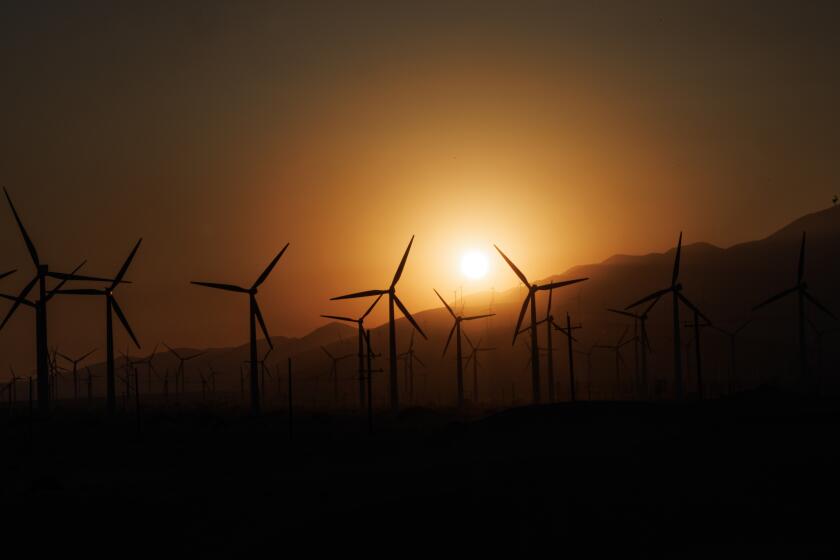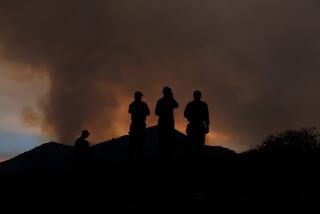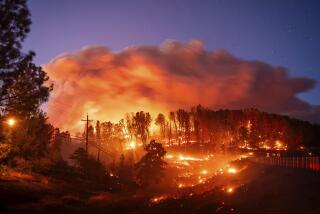Wildfire destroys 13 homes in Northern California as heat wave is parked over the West

- Share via
A wildfire that broke out near Oroville last week amid California’s record-breaking heat wave destroyed 13 homes and more than a dozen other buildings, state fire officials said.
The Thompson fire arrived Friday in lockstep with a heat wave that parked itself over the West, setting the stage for the fire to sustain itself on brush and vegetation in extreme heat and dry winds in Butte County. Over the weekend, it grew to 3,789 acres before it was declared 100% contained Monday by the California Department of Forestry and Fire Protection.
“The word that our fire chief has been using to describe the fire is ‘stubborn,’” Cal Fire spokesperson Rick Carhart said. “The fire broke out on a day that was extremely hot, quite windy and the humidity was almost nothing.”
The heat wave scorching interior California pushed dozens of cities to triple-digit temperatures, setting several daily records Wednesday and Thursday.
The fire was fanned by 20 mph north winds and burned through steep terrain, putting a strain on firefighters.
Thirteen single-family homes were destroyed, five homes were damaged, and 13 other buildings were also destroyed, according to Cal Fire. Two firefighters have been injured, Carhart said. There have been no reports of civilian injuries.
Though the Thompson fire is contained, the lingering heat wave sets the stage for more dry conditions with extreme heat that could drive more fast-moving wildfires and stretch firefighting resources thin. Temperatures on Tuesday continued to linger 10 to 15 degrees above average across huge swaths of the state and showed no signs of letting up until the weekend.
“That prolonged heat really makes a big difference that stresses the vegetation and especially the firefighters,” said Alex Tardy, a meteorologist with the National Weather Service in San Diego.
Track wildfire origins, perimeters and air pollution with the L.A. Times California wildfires map.
Among the other fires in the state, the Vista fire is burning in the San Bernardino National Forest near Mt. Baldy and Wrightwood, the U.S. Forest Service said.
The fire nearly doubled in size overnight and has burned 1,295 acres since it started Sunday afternoon in steep, remote terrain. Details on the fire’s containment were not immediately available.
The area is flush with vegetation now in the heat after a strong rainy season.
“That area near Lytle Creek is the wettest part of the mountain, with a lot of vegetation,” Tardy said. “That means a lot of fuels are already in place.”
The severity and persistence of this heat wave is unprecedented, according to meteorologists, setting numerous records for high temperatures across the Golden State and the Western United States.
Lancaster and Palmdale continued to stretch their all-time record of consecutive days at or above 110 degrees, reaching five days on Monday, according to the National Weather Service. The prior record for both Antelope Valley cities was three days.
Las Vegas is expected to break its all-time record for consecutive days at 110 degrees or above, hitting five days in a row Monday. The current record is 10 days in a row, but forecasts show temperatures will remain that high through next week, easily toppling the previous record.
Several other areas, including Madera and Needles, also hit daily record highs on Monday, according to the National Weather Service. Palmdale reached 112 degrees on Monday, recording above normal temperature for the fourth day in a row.
Madera hit 110 degrees, beating a record by three degrees; Merced hit 109 degrees, inching past its daily record from 1921; Las Vegas hit 115 degrees, one degree above its prior July 8 record set in 2021; and Needles, in the Mojave Desert, hit 123 degrees, breaking its July 8 record from 2017 by three degrees.
In Santa Barbara County, a wildfire forced residents near Figueroa Mountain to leave their homes as authorities issued evacuation orders Monday.
The Lake fire continues to burn on the western edge of the Los Padres National Forest amid record low levels of moisture, according to the U.S. Forest Service. The fire, first reported Friday afternoon northeast of the city of Los Olivos, has burned 26,176 acres to become the biggest fire in California so far this year, officials said.
The fire is burning near Zaca Lake and several residential properties including the Sycamore Valley Ranch, formerly Michael Jackson’s Neverland Ranch. Firefighters reported 16% containment as of Tuesday evening.
An evacuation is in effect for parts of Figueroa Mountain, south of Tunnel House at Sisquoc River, east of Figueroa Creek, north of the southern end of Cachuma Mountain, and west of Los Padres National Forest areas, officials announced on Monday. Though most of the fire’s growth overnight occurred in isolated pockets of forest, it pushed evacuation warnings Tuesday to the edge of communities in Los Olivos and Santa Ynez and triggered expanded evacuation orders to Goat Rock, east of Figueroa Creek, north of the U.S. Forest Service entrance at Happy Canyon Road and south of Cachuma Mountain.
The National Weather Service issued a red flag warning for the area Tuesday afternoon because of high winds and extreme heat.
“It’s hot, dry and stronger winds are in effect today,” said fire behavior analyst trainee Dan Michael with the Interagency Incident Management team responding to the fire.
Even at night when fire activity usually dies down, the Lake fire has remained active because it’s burning on top of mountain ridges where it can be 30 degrees or more warmer than lower elevations, Michael said.
“The marine layer comes in and it’s not able to reach where the fire is burning,” Michael said. “The conditions are much worse at night.”
Los Angeles Times staff reporters Keri Blakinger and Grace Toohey contributed to this story.
More to Read
Sign up for Essential California
The most important California stories and recommendations in your inbox every morning.
You may occasionally receive promotional content from the Los Angeles Times.













